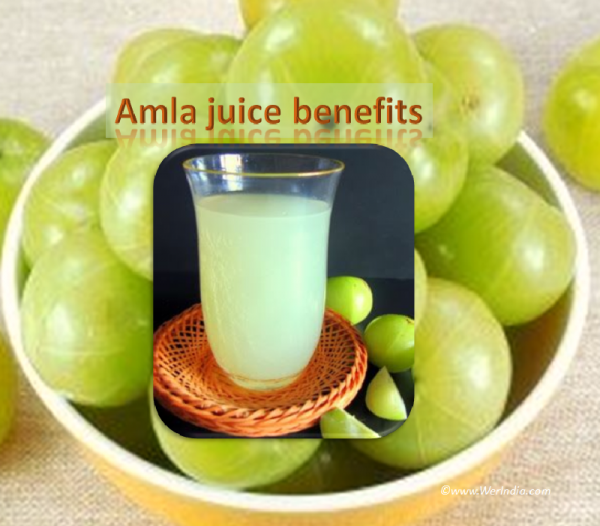
Amla, amla juice and benefits
Amla, Indian gooseberry is rich with vitamin C and has several health benefits.
It is a seasonal fruit and not available in all seasons. Sometimes you might find the frozen fruits in in frozen vegetable section.
There are different ways to store amla for all seasons and can use it whenever you want.
- Dry amla: Wash and cut amla into small pieces and remove seed. Sun dry these pieces till pieces lose water and green color. It becomes dark. Store in an airtight container and use it according to your need.
- Amla powder: After drying amla, one can make powder. Powder can be added to curry in smaller amounts.
- Dry amla with salt: Wash and cut amla into small pieces. Put in a vessel, add salt. Mix well. After a day or two remove amla and sun dry till the color changes by losing water. Store salted amla in airtight container. Use it to prepare amla rasam or yogurt based dishes.
- Freeze cut amla: Wash and cut amla. Remove water and store in zip lock bags for long term use.
- Amla pickle: Wash and cut amla. Put it in salt. Mix well and leave it for few days in dark area. In between keep mixing the content and make sure there is no fungal growth. Once you feel amla absorbed enough salt, then add necessary spices – chilli powder, asafetida, little more salt – Take enough oil and season with mustard. Mix well and store in air tight container.
- Amla juice: Another way to use amla is extracting concentrated amla juice and store it in a bottle.
-To prepare amla concentration you need, fresh amla – about a kilo and double folded cloth.
Wash amla in clean water. Cut into small pieces and take out the seeds. Transfer amla pieces into a mixing jar or grinder and prepare a paste. Transfer the paste to double cloth and squeeze it tightly and extract the juice in a bowl. Keep pulp in a separate plate. Repeat the procedure of grinding and squeezing with rest of the amla. From one kilo amla you will be able to get 500 grams of juice. Refrigerate juice in a bottle. You should consume this concentrated juice in next 2-3 weeks. For longer term use, one can add sodium lactate preservative (1 tsp). If you don’t like to use preservative then prepare the amount as per your need and use it before fungus gets in the juice.
Use the pulp to make chutney or amla murabba.
How to use concentrated amla juice?
- Amla juice to drink: Take 2 Tbsp concentrated amla juice and to this add 3 tsp honey, ¼ tsp cardamom powder, 2 tsp sugar, ¼ salt and ½ cup water. Mix well and serve. Best time to consume amla juice is morning hours.
- You can add concentrated amla while preparing lemon rice. Instead of lemon juice, use amla juice.
- Drink amla juice with little honey in the morning to boost immune system.
- Add to henna and apply on hair for hair growth.
- Mix with oil and massage on scalp for hair growth and to avoid early graying of hair
- It is a good laxative –It is alkaline in nature once enters the body and flushes out all toxins. Add one tsp of amla juice to half a glass warm water and drink in morning.
- Mix concentrated amla (one tsp) with little honey and consume to reduce mouth ulcers and it also helps in taste bud enhancement.
- Regular consumption of amla juice helps in improving physical weakness
- Vitamin C content makes it a good remedy cold.
- Add 1 tbsp amla juice to 1 cup water and add little salt and consume it – this helps to reduce the belly fat and reduces cholesterol level.
- Amla juice with aloe vera juice helps to reduce hair fall issues!
- Mix little amla juice with olive oil and massage on face. It reduces pigmentation and gives a clear skin.
- It is good for diabetes – mix amla juce with Indian blackberry (jamun) juice and bitter gourd (karela) juice and consume half a glass everyday (seek your doctor’s advice if needed).
- Two tsp of amla juce with equal amount of honey consumed everyday helps in reducing cold and cough.
- Mix 1 tsp amla juice with 1 tsp ginger juice and add little salt and ½ cup water. Drink this to get good appetite.
Amla is beneficial for many such reasons. Because of these reasons, it is one of the preferred medicinal herb in Ayurveda and for home remedies.
Author: Sumana Rao | Posted on: November 15, 2019








